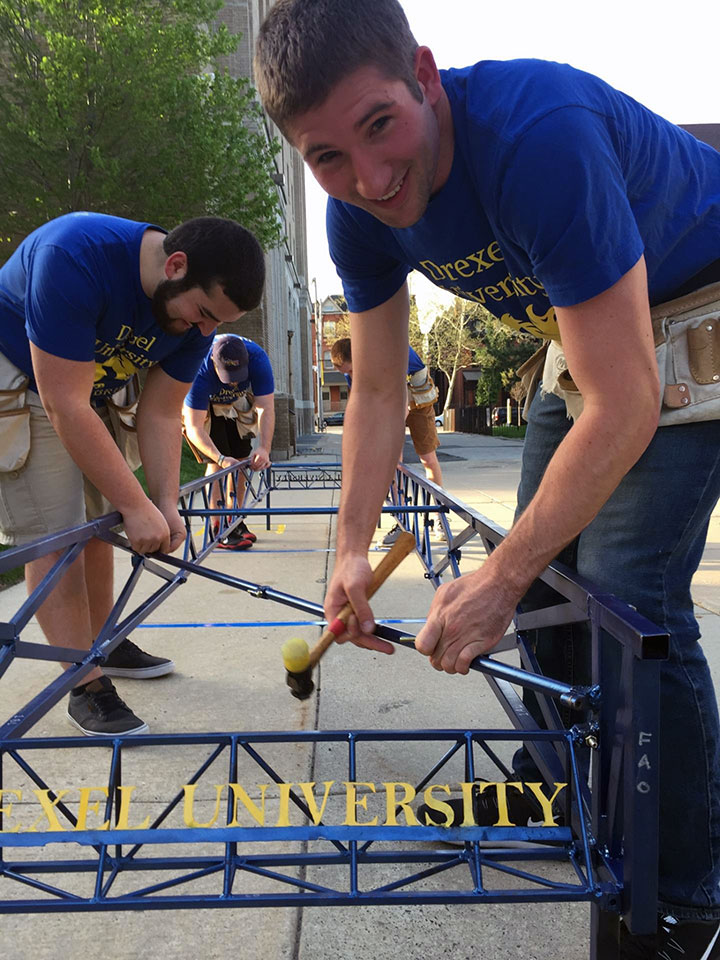00:00 seconds - All team builders ready; all pieces laid out in tool zone.
00:50 - Long trusses going into place.
01:55 - Two builders holding up partial structure; two builders ferrying parts.
04:48 - Lateral members being locked into place.
07:40 - “We got one more bolt…”
07:53 - Finished. The bridge is entirely built. It weighs in at 133 pounds and is capable of bearing a 2,500-pound load, and during one particular practice run all 17 feet of it is put together in seven minutes and 53 seconds.
Next step: knock about 53 seconds off the build time.

The Drexel Steel Bridge Team practices for the competition.
The Drexel Steel Bridge Team is preparing for the 2018 National Student Steel Bridge Competition to be held in Illinois this coming weekend. Drexel’s team will face over 40 competitors, winnowed down from 230 across the country, who will assemble their entries, test the load-bearing capacity, and race against the clock and each other in one of civil engineering’s most anticipated collegiate competitions.
To compete at the national level, students are required to conceptualize, design, fabricate and test mini-bridges that will be assembled within a taped-off competition area simulating a bridge construction site – including a four-foot-wide “river,” which team members are prohibited from stepping into. At regionals this year, Drexel’s team took several first-place prizes, in categories for display, lightness, and efficiency.
Most important of all, they had the fastest construction speed, building out in seven minutes and 20 seconds – at least three minutes faster than the other 11 regional teams – and thus earned their way to nationals.
The competition, now in its 26th year, will be held over Memorial Day Weekend at the University of Illinois at Urbana-Champaign. Organizing sponsors are the American Institute of Steel Construction and the American Society of Civil Engineers. This is Drexel’s third-straight year of having an active steel bridge team, and the second in which they have qualified for nationals.
Drexel is anticipating hosting the national competition in 2021.
All Trussed Up
Painted in Drexel colors, with bright gold lettering, the team bridge is a simple span truss system that accommodates the 40 pages of contest requirements team members pored through beginning last October. Their entry looks a bit like a ladder lying on its side. That’s partly by design and partly by default: the team had a fairly skeletal design budget this year and so used pieces, called “members” in competition parlance, from previous competitions in order to save on cash.
There are eight Steel Bridge members, all of them from the College of Engineering.
Asked if the team simply designs for function or if members try to create an elegant, memorable span, Kevin Robinson, co-captain of the team, responded as any engineer would – with practicality.
“The competition does have a design aspect, so you get judged on how your bridge looks. But most of it is speed,” said Robinson, a pre-junior majoring in civil engineering. “The real point of the competition is to build a bridge yourself and have fun doing it. Even the rules specify that it’s all about the fun of building.”
“However,” added sophomore Kyle Carstensen, who is majoring in architectural engineering, “we did get a first place this year in display.”
Specs to Compete by
Each fall, competing teams receive a thick packet of specifications that they must observe, including a problem statement drawn from a real-world construction scenario. This year, contest organizers based the specs on a bridge in Seattle, WA that had to be constructed without temporary support in the water or on the embankment.
“I think that was the biggest ‘oh no’ moment when we saw the rule packet; no temporary piers,” said Josh Gable, co-captain and the team’s only senior. Gable will graduate in June with a BS in civil engineering.
“The past two years, we were allowed to use those in competition. So not being able to support the bridge temporarily—unless we used a builder person to support its weight while the rest were building it—was one of the biggest issues we had to overcome,” he said. “While we were designing it, we had to consider how we were going to build it, too, and that’s one of the hardest parts of the design process.”
After several meetings, an initial design and several fabrication stages (with parts cut in Drexel’s machine shop using bandsaws and mills and then welded together in their lab space), the team decided to solve that problem by using four builders in total – two of whom will support the bridge after the foundation is in place, and two of whom will ferry “members” from the tool zone. Adding more builders would cost contest points; having fewer builders would cost time.
The strategy has paid off for the team so far, as their build times have been consistently low.
Alumnus Michael Whelan, CAEE ’12, is serving as the team’s alumnus advisor. He competed in steel bridge competitions in both 2011 and 2012.

Members of The Drexel Steel Bridge Team
“Each year I am impressed with the students’ commitment to independently overcome the design, fabrication, and project management challenges this competition presents,” said Whelan. “Qualities important to an outstanding steel bridge team include a focus on bridge design for fabrication and constructability, and effective management of time, materials, and individual skills.”
The Drexel team departs Thursday with a truck full of equipment, all packed according to specific size specs. They will face teams from throughout the country, several international teams, and last year’s returning champions from Ecole de technologie superiere.
Team members say they have gained a great deal of practical knowledge about deflection, design software, load testing, loading rails and diagonal supports, how forces get distributed, welding, and teamwork. But they’ve also internalized a thing or two about economy.
“We’re going to drive to the competition to save money,” said Gable. “It’s only 12 hours. We can do it. We’re young.”